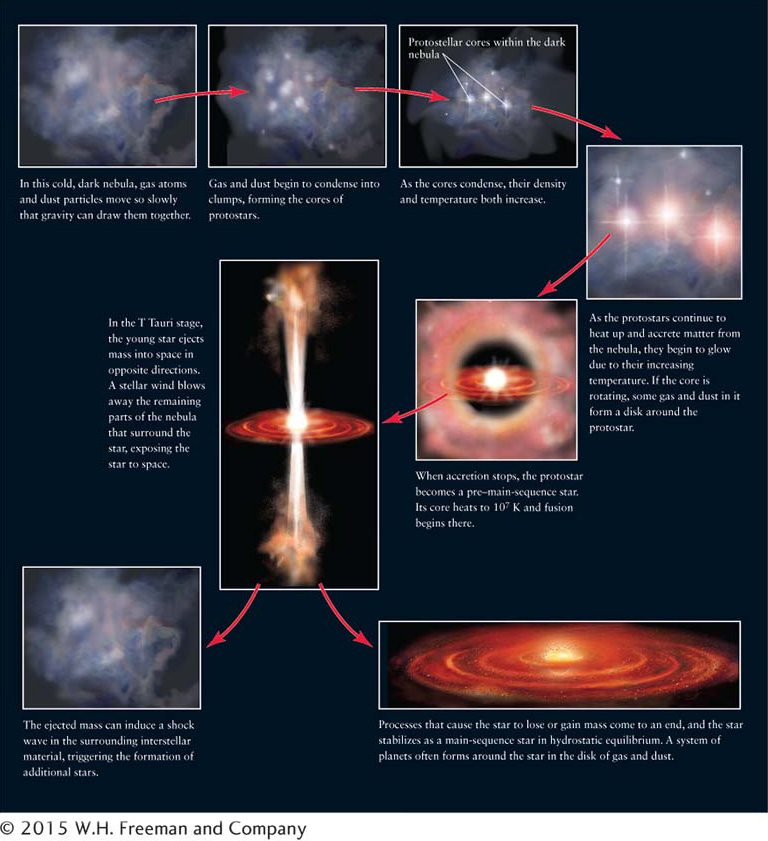MAIN-SEQUENCE AND GIANT STARS
In the first part of this chapter, we saw how stars form from dense cores of gas and dust inside giant molecular clouds. As these cores collapse, the gas and dust in their centers quickly form protostars. Eventually, protostars have pulled in (accreted) most of the mass available to them and they become pre–main-sequence stars that slowly contract. As a pre–main-sequence star evolves, fusion begins in its core.
Recall from Chapter 9 that in our Sun, thermal pressure created by fusion in the core pushes outward, everywhere balancing the inward force of gravity so that the Sun neither expands nor collapses. The Sun is said to be in hydrostatic equilibrium (see Figure 9-21). When each layer of a pre–main-sequence star can finally support all of the layers above it (meaning that collapse ceases), that star also comes into hydrostatic equilibrium, and a main-sequence star is born (see Figure 11-11). Main-sequence stars are those stars in hydrostatic equilibrium, with nuclear reactions fusing hydrogen into helium in their cores at nearly constant rates. Figure 11-18 summarizes the star formation process.

Figure 11-18 A Summary of the Star Formation Process This set of drawings takes you through the star formation process for the Sun and other stars with less than about 1.5 solar masses.
11-7 Stars spend most of their lives on the main sequence
The zero-age main sequence (ZAMS) is the set of locations on the H-R diagram where pre–main-sequence stars of different masses first become stable objects, neither shrinking nor expanding. This sequence is denoted by the solid red line that appears on several of the H-R diagrams in this chapter. Note that the theoretical evolutionary tracks in Figure 11-11 end at locations along the main sequence that agree with the observed mass–luminosity relation (recall Figure 10-14a): The most massive main-sequence stars are the most luminous, whereas the least massive stars are the least luminous.
Focus Question 11-7
About how long ago was the Sun a ZAMS star?
 The energy emitted by stars is primarily generated by thermonuclear fusion (see Discovery 9-1: Thermonuclear Fusion). More luminous (brighter) stars generate and radiate more energy each second than do dimmer stars. Put another way, higher-mass stars are consuming more fuel than are lower-mass stars. This raises the interesting question of whether higher-mass stars have enough extra nuclear fuel to shine longer than lower-mass stars. The answer is no. The equations of nuclear fusion reveal that higher-mass stars consume fuel so quickly that these stars actually spend less time at each stage of stellar evolution than do lower-mass stars. For example, the tremendous internal pressure created by gravity inside O stars forces them to consume all of their core hydrogen in only a few million years, as shown in Table 11-2. Conversely, stars of very low mass take hundreds of billions of years to convert their cores from hydrogen into helium. Because, as we will see, the universe is roughly 14 billion years old, no main-sequence star with mass less than about 0.75 M⊙ has yet moved into the next stage of stellar evolution.
The energy emitted by stars is primarily generated by thermonuclear fusion (see Discovery 9-1: Thermonuclear Fusion). More luminous (brighter) stars generate and radiate more energy each second than do dimmer stars. Put another way, higher-mass stars are consuming more fuel than are lower-mass stars. This raises the interesting question of whether higher-mass stars have enough extra nuclear fuel to shine longer than lower-mass stars. The answer is no. The equations of nuclear fusion reveal that higher-mass stars consume fuel so quickly that these stars actually spend less time at each stage of stellar evolution than do lower-mass stars. For example, the tremendous internal pressure created by gravity inside O stars forces them to consume all of their core hydrogen in only a few million years, as shown in Table 11-2. Conversely, stars of very low mass take hundreds of billions of years to convert their cores from hydrogen into helium. Because, as we will see, the universe is roughly 14 billion years old, no main-sequence star with mass less than about 0.75 M⊙ has yet moved into the next stage of stellar evolution.
TABLE 11-2
MAIN-SEQUENCE LIFETIMES
|
|
|
|
Time on main sequence (106 years) |
|
|
|
|
|
|
|
|
|
|
|
|
|
|
|
|
|
|
|
|
|
|
|
|
|
|
|
|
|
|
|
|
|
|
|
|
|
|
|
|
|
|
|
The equations further reveal that the conversion of hydrogen into helium in every star’s core takes a long time compared to any other stage of its stellar evolution. (These stages are presented in the following sections and the next chapter.) That is why the vast majority of stars represented on an H-R diagram are located on the main sequence. This raises another intriguing question: Because most stars are on the main sequence, why are most of the stars visible to the naked eye non-main-sequence stars? The answer will become apparent shortly.

 The energy emitted by stars is primarily generated by thermonuclear fusion (see Discovery 9-
The energy emitted by stars is primarily generated by thermonuclear fusion (see Discovery 9-